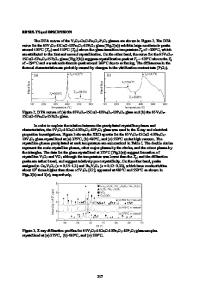Magnetic and Electrical Properties of Glass and Glass-Ceramics Based on Weathered Basalt
- PDF / 7,195,159 Bytes
- 20 Pages / 595.276 x 790.866 pts Page_size
- 14 Downloads / 356 Views
ORIGINAL PAPER
Magnetic and Electrical Properties of Glass and Glass-Ceramics Based on Weathered Basalt G. A. Khater 1 & Bassem S. Nabawy 2 & Junfeng Kang 3 & Yunlong Yue 3 & M. A. Mahmoud 1,4 Received: 7 October 2019 / Accepted: 10 January 2020 # Springer Nature B.V. 2020
Abstract A total of six glass batches (WB100-WB50) based primarily on weathered basalt with successive addition of bypass cement dust (with the weight content 0–50%) were melted at 1450 °C and cast into glass specimens then crystallized into glass-ceramic through applying heat treatment at 1000 °C for 2 h. The dielectric constant (ε’), dielectric loss (ε”) and electric conductivity (σ) of both the glass and glass-ceramic samples were measured by applying the alternating current (AC) field and scanned at 1500 points in frequency range 50 Hz up to 7.5 MHz. A relatively high conductivity was assigned for the glass sample WB60 at the low frequency (50HZ) with value 1.85 μS/cm and for the glass-ceramic samples WB100 at higher frequencies (7.5 MHz) with value 3440 μS/cm. Besides, magnetic properties of the glass-ceramics were measured using a hysteresis magnetic loop technique up to 20 kg. The highest magnetization is assigned for samples WB100 and WB60 with value 3.074 and 2.914 emu/g, respectively; whereas the lowest values assigned for samples WB50 with value 0.209 emu/g. In order to achieve the best characterization of the obtained mixtures and to explain their electric and magnetic behavior as a function of the applied frequencies and magnetic field, various experimental techniques were applied in this study including, DTA, XRD, and SEM. The DTA indicated a gradual increase in the exothermic temperature by increasing the bypass content from WB100 to WB50. XRD analysis indicated that major crystalline phases are diopside, anorthite, wollastonite, gehlenite, magnetite and hematite. SEM indicated that the best crystal size is obtained for the samples WB60 and WB70. Keywords Weathered basalt . Glass . Glass-ceramic . Dielectric . Magnetic . Semiconductors
1 Introduction Glass-ceramics remain polycrystalline materials formed through controlled crystallization of mother glasses. Glassceramic materials have significant properties such as a zero porosity, high bending strength, ferromagnetism, great chemical durability, superconductivity and dielectric constant. In addition, they are characterized by low dialectic
* G. A. Khater [email protected] 1
Glass Research Department, National Research Centre, Cairo, Egypt
2
Geophysical Sciences Department, National Research Centre, Cairo, Egypt
3
School of Materials Science and Engineering, University of Jinan, Jinan 250022, China
4
FunGlass - Centre for Functional and Surface Functionalized Glass, Alexander Dubček University of Trenčín, Trenčín, Slovakia
constant, loss high resistivity, break-down voltage, opacity and low or even negative thermal expansion coefficient and high-temperature stability. These properties can be tailored by controlling the base-glass composition and by controlled the heat
Data Loading...











